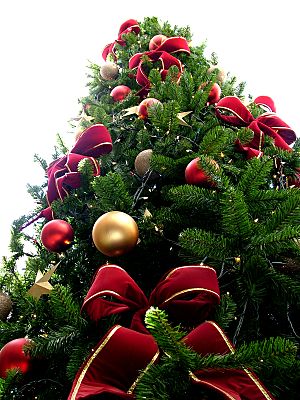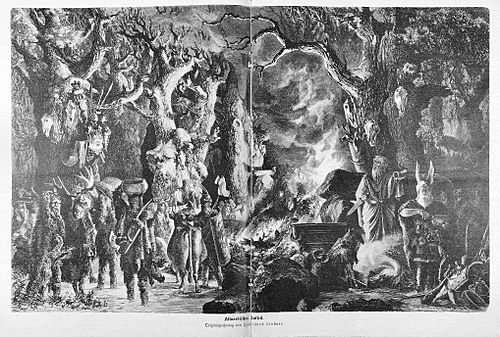Yule facts for kids
Yule (also called Jul, jól, or joulu) is an old winter festival. It was celebrated long ago by the Germanic peoples, who lived in Northern Europe. Experts believe the first Yule celebrations were connected to old stories like the Wild Hunt, the god Odin, and a pagan Anglo-Saxon festival called "Mothers' Night."
When Christianity spread, Yule traditions changed and mixed with Christian ones. This is how the term Christmastide became popular. Many Christmas customs we know today, like the Yule log (a special log burned in the fireplace), the Yule goat, the Yule boar, and Yule singing, might have come from these older Yule traditions. The word "Yule" is still used in English and in many Scandinavian languages, as well as in Finnish and Estonian, to describe Christmas and other winter holidays.
Contents
What Does the Word "Yule" Mean?
The word "Yule" comes from the Old Norse word Jól. It is also linked to Jólnir, one of the names for the god Odin. In Old English, words like ġēol or ġēohol referred to a 12-day festival of Yule. Other Old English words, ġēola or ġēoli, meant the "month of Yule." For example, ǣrra ġēola was the time before Yule (December), and æftera ġēola was the time after Yule (January).
These words are similar to words in other old languages, like Gothic jiuleis. In modern languages like Icelandic, Faroese, Danish, Swedish, and Norwegian, the word for Christmas is often similar to "Yule" (like jól or jul). The word Yuletide, meaning the Yule season, first appeared around the year 1475.
In old Norse poems, Odin, who had a long beard, was sometimes called Jólnir (meaning 'the Yule one'). Some old writings from the 12th century even say that Christmas, or jól, got its name from Odin's name, Jólni(r). Sometimes, the word jóln (plural) could even refer to all the gods together. In old poetry, "Yule" could also mean a 'feast', like hugins jól (a raven's feast).
Yule in Ancient Germanic Times
Yule was a very important winter festival for the ancient Germanic peoples. The earliest mentions of Yule are found in month names. The Yule period often lasted for about two months, from mid-November to early January in our modern calendar.
Early Records of Yule
We know about Yule from very old records. In a Gothic calendar from the 5th or 6th century, a month was named fruma jiuleis. In the 8th century, an English historian named Bede wrote that the Anglo-Saxon calendar had months called geola or giuli. These months matched either our December, or both December and January.
In Old Norse writings, the month name ýlir is also found. But there are also many mentions of the festival itself, called jól. In a book called Skáldskaparmál, which is part of the Prose Edda, the gods are sometimes called "Yule-beings." An old poet named Eyvindr skáldaspillir wrote about "Yule-being's feast," meaning a feast for the gods. Also, as mentioned, one of the many names for Odin was Jólnir, linking him to the festival.
King Haakon and Christian Yule
The Saga of Hákon the Good tells us that King Haakon I of Norway, who ruled from 934 to 961, helped bring Christianity to Norway. He also changed the Yule celebration to happen at the same time as Christian Christmas.
The saga says that when Haakon came to Norway, he was already a Christian. But the people there still followed their old pagan ways. So, Haakon kept his Christianity a secret at first to get help from powerful leaders. Over time, Haakon made a law that Yule celebrations should happen at the same time as Christmas. Everyone had to have ale (a type of drink) for the celebration, or they would have to pay a fine. They also had to keep the holiday going as long as the ale lasted.
Before this, Yule was celebrated for three nights starting from the middle of winter. Haakon planned that once he was strong and ruled the whole country, he would then "have the gospel preached." The saga says that many people liked him and allowed themselves to be baptized. Some even stopped making sacrifices to the old gods. Haakon spent most of his time in Trondheim. When he felt powerful enough, he asked for a bishop and priests from England to come to Norway. When they arrived, "Haakon made it known that he would have the gospel preached in the whole country." The saga then describes how different groups of people reacted to this change.
Yule Traditions Today
In countries where Germanic languages are spoken, and in some other Northern European countries, "Yule" and similar words still mean the Christmas holiday season. For example, in Sweden, Denmark, and Norway, Christmas is called jul. In Iceland and the Faroe Islands, it's jól. In Finland, it's joulu, and in Estonia, it's jõulud.
Modern Paganism and Yule
Today, some people who follow modern pagan religions also celebrate Yule. Since these religions have different origins and practices, their Yule celebrations can be quite different.
Some Heathens try to celebrate Yule as closely as possible to how they believe the ancient Germanic pagans did. Others celebrate with rituals that combine ideas from different sources. Heathen Yule celebrations might include sharing a meal and giving gifts.
In most forms of Wicca, Yule is celebrated at the winter solstice, which is the shortest day of the year. For them, it marks the rebirth of the Great Horned Hunter God, who is seen as the newborn sun. How people celebrate this holiday, called a sabbat, can vary. Some have private ceremonies at home, while others celebrate with their covens (groups of Wiccans).
See also
 In Spanish: Yule para niños
In Spanish: Yule para niños



